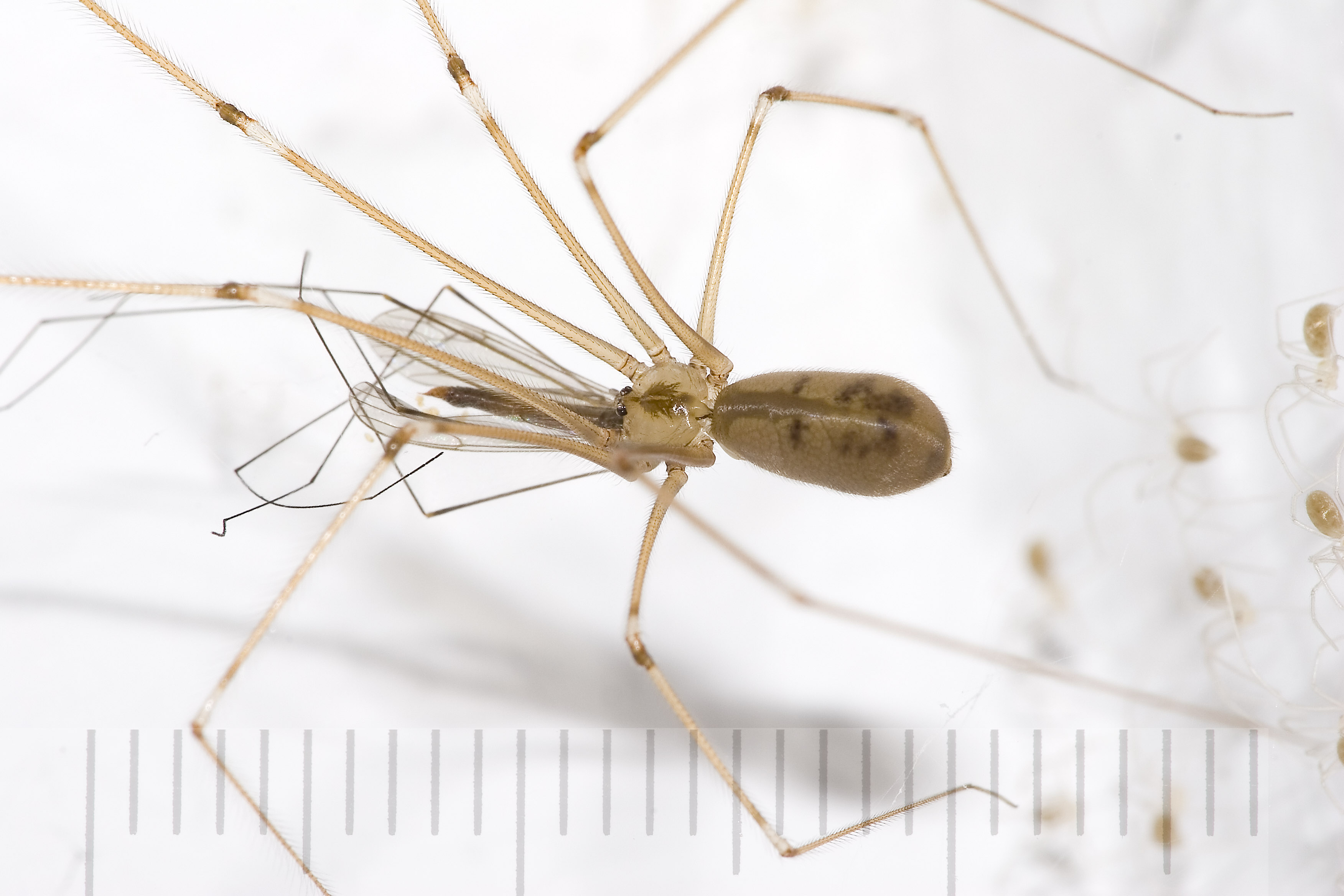|
Entelegynae
The Entelegynae or entelegynes are a subgroup of araneomorph spiders, the largest of the two main groups into which the araneomorphs were traditionally divided. Females have a genital plate ( epigynum) and a "flow through" fertilization system; males have complex palpal bulbs. Molecular phylogenetic studies have supported the monophyly of Entelegynae (whereas the other traditional subgroup, the Haplogynae, has been shown not to be monophyletic). The clade contains both cribellate and ecribellate spiders. Characterization The Entelegynae are characterized primarily by the nature of the female genital system. The ancestral ( plesiomorphic) system is found in non-entelegyne spiders, where there is a single external genital opening in the female's abdomen. One or more males inject sperm from their palpal bulbs via this opening; the sperm is usually stored in special spermathecae (absent in some spiders, e.g. ''Pholcus''). When eggs are released from the ovaries, sperm is also releas ... [...More Info...] [...Related Items...] OR: [Wikipedia] [Google] [Baidu] |
Haplogynae
The Haplogynae or haplogynes are one of the two main groups into which araneomorph spiders have traditionally been divided, the other being the Entelegynae. Morphological phylogenetic studies suggested that the Haplogynae formed a clade; more recent molecular phylogenetic studies refute this, although many of the ecribellate haplogynes do appear to form a clade, Synspermiata. Unlike the Entelegynae, haplogynes lack hardened (sclerotized) female genitalia (epigynes). Most of the species within this group have six eyes, as opposed to most other spiders. Spiders in the genus '' Tetrablemma'' (Tetrablemmidae) have only four eyes, as do some members of the family Caponiidae; caponiids may even have only two eyes. However, spiders in the family Plectreuridae have the normal eight eyes. Phylogeny The Haplogynae are one of the two major groups into which araneomorph spiders were traditionally divided, the other being the Entelegynae. In 2005, Coddington summarized the relationships of ... [...More Info...] [...Related Items...] OR: [Wikipedia] [Google] [Baidu] |
Palpal Bulb
The two palpal bulbs – also known as palpal organs and genital bulbs – are the copulatory organs of a male spider. They are borne on the last segment of the pedipalps (the front "limbs" of a spider), giving the spider an appearance often described as like wearing boxing gloves. The palpal bulb does not actually produce sperm, being used only to transfer it to the female. Palpal bulbs are only fully developed in adult male spiders and are not completely visible until after the final moult. In the majority of species of spider, the bulbs have complex shapes and are important in identification. Structure The palpal bulb of a mature male spider is borne on the last segment of the pedipalp. This segment usually has touch-sensitive hairs (setae) with nerves leading to them. The bulb itself is entirely without nerves, and hence without sensory organs and muscles, since these depend on nerves for their functioning, although some spiders have one or two muscles external to the bulb and ... [...More Info...] [...Related Items...] OR: [Wikipedia] [Google] [Baidu] |
Glossary Of Spider Terms
This glossary describes the terms used in formal descriptions of spiders; where applicable these terms are used in describing other arachnids. Links within the glossary are shown . Terms A Abdomen or opisthosoma: One of the two main body parts ( tagmata), located towards the posterior end; see also Abdomen § Other animals Accessory claw: Modified at the tip of the in web-building spiders; used with to grip strands of the web Anal tubercle: A small protuberance (tubercule) above the through which the anus opens Apodeme → Apophysis (plural apophyses): An outgrowth or process changing the general shape of a body part, particularly the appendages; often used in describing the male → Atrium (plural atria): An internal chamber at the entrance to the in female haplogyne spiders B Bidentate: Having two Book lungs: Respiratory organs on the ventral side (underside) of the , in front of the , opening through narrow slits; see also Book lungs Branchial operculum � ... [...More Info...] [...Related Items...] OR: [Wikipedia] [Google] [Baidu] |
Araneomorphae
The Araneomorphae (also called the Labidognatha) are an infraorder of spiders. They are distinguishable by chelicerae (fangs) that point diagonally forward and cross in a pinching action, in contrast to the Mygalomorphae (tarantulas and their close kin), where they point straight down. Araneomorphs comprise the vast majority of living spiders. Distinguishing characteristics Most spider species are Araneomorphae, which have fangs that face towards each other, increasing the orientations they can employ during prey capture. They have fewer book lungs (when present), and the females typically live one year. The Mygalomorphae have fangs that face towards the ground, and which are parallel to the long axis of the spider's body, thus they have only one orientation they can employ during prey capture. They have four pairs of book lungs, and the females often live many years. Image:Atrax robustus.jpg, This ''Atrax robustus'' shows the orientation of Myglamorphae fangs. Image:Che ... [...More Info...] [...Related Items...] OR: [Wikipedia] [Google] [Baidu] |


